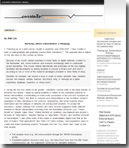| 2008 |
“Literature+”Categories Essays , Publications Essays , Publications
|
 Citation: “Literature+.” Currents in Electronic Literacy (Spring 2008). <http://currents.dwrl.utexas.edu/2008/literature-plus.html>
Citation: “Literature+.” Currents in Electronic Literacy (Spring 2008). <http://currents.dwrl.utexas.edu/2008/literature-plus.html>
¶ 1. Following up on a pilot course I taught in academic year 2006-2007, I have created a suite of undergraduate and graduate courses titled “Literature+”. The essential idea is stated on the wiki sites for the courses as follows:
¶ 6. Literature+ courses do not necessarily give a blank check to the thesis that interpreting literature should be “just like” making models, simulations, visualizations, statistical analyses, and other non-humanities constructs designed (in the vocabulary of Willard McCarty’s philosophy of modeling) to make datasets “tractable” and “manipulable.” But they play with the constraints and affordances of the dataset paradigm so as to encourage new thinking about the similarly tight yet supple constructs–forms, genres, styles, plots, characters, structures, contexts, etc.–of literature.
¶ 10. There has never been a time when world issues on the scale of globalism, terrorism, and the environment have created such a need for radical interdisciplinarity in the academy. There has never been a time when the digital tools facilitating such interdisciplinarity have been more accessible, shareable, and useable. And, from the point of view of our students (who are idealistic about the future but also worried about their careers after graduation), there has also never been a time when the workplace seems more to reward “knowledge workers” able to collaborate via digital technologies across expertises, departments, firms, and nations. My Literature+ courses are packed, drawing students from many disciplines who sense that they are in the pipeline, for better or worse, to such a future. Can the humanities prepare its students not just to survive but to shape the future into what might be called, in complementarity to Literature+ , Dataset+? I mean by this a view of the world that exceeds the usual spreadsheets, databases, reports, and other bleak expressive forms that today sum up the knowledge of business, government, etc., to afford some measure of ethical intelligence, social awareness, communicational fluency, aesthetic/design sensibility, and other cultural quotients of a robust human knowledge?
¶ 11. Of course, a skeptic responding to such idealism might be suspicious that asking students to take a literary work and do anything with it other than literary interpretation in preparation for a more robust knowledge work can only be a recipe for dilution, popularization, and philistinism. But I have rarely, if ever, seen students more truly engaged with literature than in these courses, where they decide what is essential about a work that must be modeled in new paradigms and technologies so as to make literary experience tractable and manipulable in other disciplinary world views. During the studio/lab classes, I rotate among student teams to ask such questions as, “So what is this work really about? What does your project have to carry over no matter what?” Given that responsibility, students act as if they were at the sensitive stick of a jet fighter called literature.
